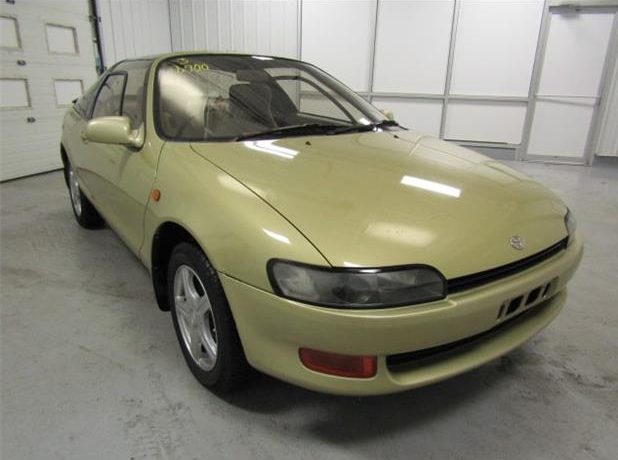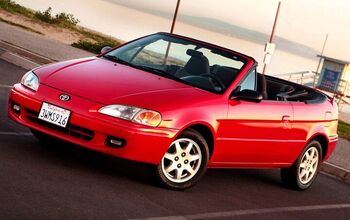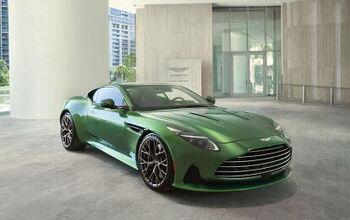Rare Rides: The Paseo-adjacent 1991 Toyota Sera

Only one car combines cheap and cheerful motoring with economical driving and butterfly doors. Fittingly, its Tercel and Paseo siblings were also dredged up in this QOTD post.
It’s the Toyota Sera, from 1991.
Toyota previewed the concept that would become the Sera in 1988, calling it the AXV-II. Radical butterfly doors combined with a roof made mostly of glass for a very slick, eye-catching design. Onlookers were duly pleased when Toyota released the Sera in 1990 in a production format that saw very few changes from the concept.
A four-seat hatchback, the Sera was intended as a downmarket alternative to the popular MR-2. Never intended for sale outside the Japanese market, the Sera was sold only at Toyota’s Corolla Store. Imagine having a store just for Corollas in North America. What a Scion ridiculous idea!
The unique hatchback style was the only one offered on the Sera, and all trim levels used the same engine: a 1.5-liter inline-four from its brother, the Paseo. Toyota did see fit to offer different transmissions to its customers; a four-speed automatic and a five-speed manual were available.
Air conditioning was standard on all Seras, given the extensive use of glass, and this economical hatchback was one of the first vehicles to use projector HiD lamps. The cars were built in phases, and each phase determined the general color schemes available to buyers. Phase I was 1990 and 1991, the period when the majority of Seras (over 12,000) were produced. Phase II spanned 1991 and 1992, and the final Phase III was 1992 through 1995. In total, 18,852 Seras were built. When production ended, there was no official replacement for the Sera. At least the MR-2 would soldier on.
Today’s Rare Ride is a rarer example from Phase II, in light green. With an automatic transmission and in need of some cleaning, Duncan Imports asks $9,998.
[Images: seller]

Interested in lots of cars and their various historical contexts. Started writing articles for TTAC in late 2016, when my first posts were QOTDs. From there I started a few new series like Rare Rides, Buy/Drive/Burn, Abandoned History, and most recently Rare Rides Icons. Operating from a home base in Cincinnati, Ohio, a relative auto journalist dead zone. Many of my articles are prompted by something I'll see on social media that sparks my interest and causes me to research. Finding articles and information from the early days of the internet and beyond that covers the little details lost to time: trim packages, color and wheel choices, interior fabrics. Beyond those, I'm fascinated by automotive industry experiments, both failures and successes. Lately I've taken an interest in AI, and generating "what if" type images for car models long dead. Reincarnating a modern Toyota Paseo, Lincoln Mark IX, or Isuzu Trooper through a text prompt is fun. Fun to post them on Twitter too, and watch people overreact. To that end, the social media I use most is Twitter, @CoreyLewis86. I also contribute pieces for Forbes Wheels and Forbes Home.
More by Corey Lewis
Latest Car Reviews
Read moreLatest Product Reviews
Read moreRecent Comments
- Spectator Wild to me the US sent like $100B overseas for other peoples wars while we clammer over .1% of that money being used to promote EVs in our country.
- Spectator got a pic of that 27 inch screen? That sounds massive!
- MaintenanceCosts "And with ANY car, always budget for maintenance."The question is whether you have to budget a thousand bucks (or euro) a year, or a quarter of your income.
- FreedMike The NASCAR race was a dandy. That finish…
- EBFlex It’s ironic that the typical low IQ big government simps are all over this yet we’re completely silent when oil companies took massive losses during Covid. Funny how that’s fine but profits aren’t. These people have no idea how business works.







































Comments
Join the conversation
I like the design. It is different. But if it was sold only in Japan, why are the controls marked with English lettering, not Japanese?
I thought these were banned because of the doors? How do they function in a rollover accident?